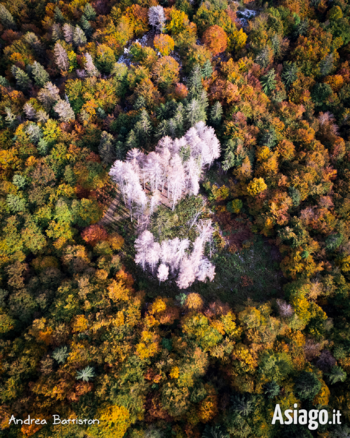Published 27 Oct 2022 - 18.42
Environment and Nature

Another serious threat to the woods of the Asiago plateau: the spruce bark beetle kills spruce
At the end of October 2018, storm Vaia caused millions of trees to fall, resulting in the destruction of tens of thousands of hectares of alpine coniferous forests. It was a real natural disaster, the consequences of which are still evident today even in the woods of the Asiago plateau.
However, in addition to the enormous direct damage of this extreme meteorological phenomenon, today there is one indirect, but no less serious and worrying: our forests, in fact, are suffering another massacre, the one caused by the TYPOGRAPHER bark beetle (Ips typographus).
It is a small beetle, whose presence, endemic in the woods of the southern Alpine arc, has turned into an epidemic, causing the death of thousands of plants, especially spruces, so much so that it has earned the nickname of "Covid" of the forests.
To cause all this was Vaia, which determined the ideal conditions for the uncontrolled proliferation of the bark beetle: after the storm this insect has known, in fact, an exponential spread favored by the presence and permanence on the ground of a huge amount of felled trees , due to the difficulty of the clearing operations made long and complicated by the huge number of fallen plants, the difficult accessibility of some areas and the vastness of the affected areas.
As if that were not enough, even the climatic conditions following the storm, with mild winters, early springs and hot and dry summers, favored the reproduction of the insect and its spread.
The bark beetle, naturally present in our woods, in normal conditions does not represent a danger, indeed it plays an important ecological role, as it attacks trees already suffering or at the end of their life cycle, contributing to the transformation of wood into humus and thus to the fertilization of the soil.
However, after Vaia, with the large amount of trees felled, the spruce bark beetle found favorable conditions for an enlarged reproduction: the crashed woody material constituted an important availability of food for the insect, which thus had the opportunity to reproduce on a large scale, its population grew exponentially, also affecting plants that survived the storm but weakened and therefore more vulnerable to its attack.
The bark beetle penetrates the trunks and digs a dense network of tunnels, invisible from the outside because under the bark, which compromise the circulation of the sap and thus dry the plants, which undergo a rapid change of color: from green they first become dark red and then gray, finally losing the needles. The trees remain standing, dead.
A parallel between the Great War and the Vaia storm was often highlighted, two extreme events that shook our plateau. And this is even more true today for another reason: a similar phenomenon, in fact, had also manifested itself during the First World War, when in the mountain areas where fighting and battles were held, the large amount of trees damaged by bombs or felled to hinder the movements of opposing armies had favored the anomalous and massive reproduction of the spruce bark beetle.
The current infestation, which mainly concerns the Alpine arc of Trentino and Veneto, including the Altopiano dei Sette Comuni, is so extensive that at the moment it is difficult to intervene. It is not even foreseeable when the infestation will return to an endemic situation, although scholars of the phenomenon believe that the peak should take place in the two-year period 2023-2024 and that then it will take about another five years to return to a situation of endemic presence of the bark beetle. However, careful and constant monitoring of the situation continues.
The only type of intervention that is being implemented is the felling and timely removal of diseased plants to prevent the further spread of the epidemic. Experts are also considering a long-term solution, namely to encourage the spread of mixed forests, stronger and more resistant, instead of the current monospecies formations of spruce, which is the tree most used by the timber industry, but which is also very delicate.
Already thirty years ago Mario Rigoni Stern pointed out that at the end of the First World War it was a mistake to replace deciduous plants with monospecies coniferous plants such as spruce, more fragile in the roots and more easily knocked down by the wind, as well as more attacked by pests. Our beloved writer was not wrong.
All rights reserved.